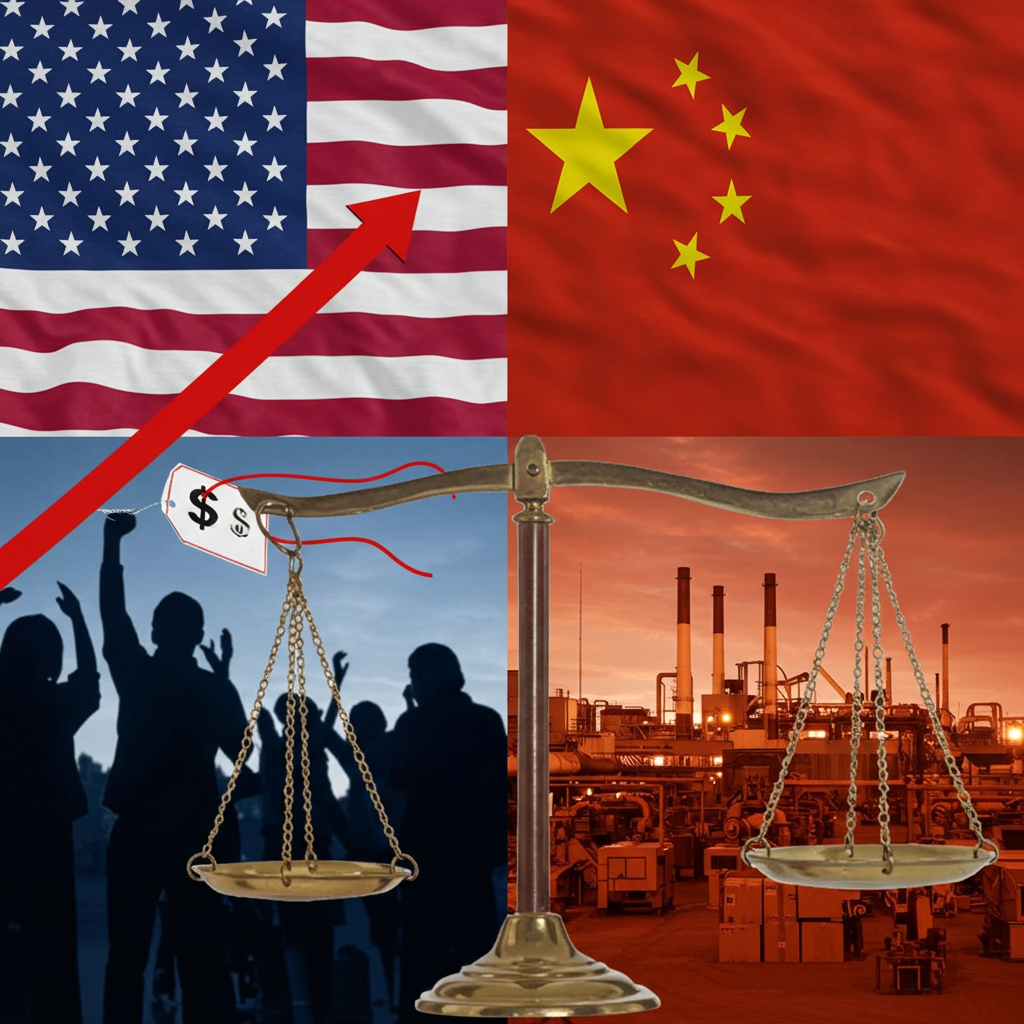Discover insights on how tariffs impact US consumers more than the Chinese economy. Explore expert analysis and implications for trade relations.
In recent years, the trade relationship between the United States and China has been a focal point of economic discourse. With tariffs being a prominent tool in this complex relationship, the implications of these trade policies have sparked debates among economists, policymakers, and consumers alike. An insightful perspective has emerged from various advisers and analysts, suggesting that China is acutely aware that tariffs primarily impact American consumers more than they do the Chinese economy. This blog post delves into this narrative, exploring the mechanics of tariffs, their effects on both economies, and the broader implications for international trade.
Understanding Tariffs: A Basic Overview

Tariffs are taxes imposed by a government on imported goods. They are designed to protect domestic industries by making foreign products more expensive, thereby encouraging consumers to buy locally produced goods. In theory, this should bolster the domestic economy by promoting local businesses and preserving jobs. However, the reality is often more complicated, particularly in the context of the US-China trade relationship.
The United States has imposed tariffs on a wide range of Chinese products, citing issues such as unfair trade practices, intellectual property theft, and a significant trade deficit. The intention behind these tariffs is to level the playing field for American manufacturers and reduce dependence on Chinese goods. However, the repercussions of these tariffs extend beyond the borders of China, significantly affecting American consumers.
The Impact on American Consumers

One of the most critical aspects of the tariff debate is understanding who ultimately bears the burden of these taxes. Numerous studies and analyses have shown that tariffs lead to higher prices for consumers. When tariffs are placed on imported goods, manufacturers often pass these costs onto consumers, resulting in increased prices for everyday products.
For instance, tariffs on electronics, clothing, and household goods mean that American consumers pay more for items that were previously affordable. This price increase disproportionately affects low- and middle-income families, who spend a larger portion of their income on consumer goods. As a result, the purchasing power of American consumers diminishes, leading to a potential slowdown in overall economic growth.
Moreover, the imposition of tariffs can create a ripple effect throughout the economy. Higher prices can lead to reduced consumer spending, which in turn impacts businesses. Companies may experience decreased sales, prompting them to cut back on production, reduce their workforce, or even close their doors. This cycle can lead to job losses and increased economic uncertainty, further straining the American economy.
The Chinese Economy: Resilience Amidst Tariffs
While the United States grapples with the consequences of tariffs, the Chinese economy has shown remarkable resilience. China has long been a manufacturing powerhouse, with a vast network of supply chains and a diverse economy that can adapt to changing global conditions. Although tariffs have undoubtedly impacted specific sectors, the overall effect on the Chinese economy has been relatively muted.
Chinese manufacturers have responded to tariffs by seeking new markets, diversifying their product offerings, and investing in technology. Additionally, the Chinese government has implemented policies to support domestic industries, ensuring that they remain competitive despite external pressures. As a result, many Chinese companies have found ways to mitigate the impact of US tariffs, allowing them to maintain profitability and continue growing.
Furthermore, the Chinese economy benefits from a large domestic market. With a population of over 1.4 billion, there is significant demand for a wide range of products and services. This internal market provides a buffer against the volatility of international trade, allowing Chinese companies to focus on domestic consumption when faced with external challenges.
The Strategic Calculus: What Does China Know?
Advisers and analysts argue that China is acutely aware of the dynamics at play regarding tariffs and their impact on American consumers. This understanding shapes China’s strategic approach to trade negotiations and economic policy. By recognizing that tariffs hurt American consumers more than they do the Chinese economy, China can leverage this knowledge to its advantage.
For instance, China may choose to engage in negotiations with the United States from a position of strength, knowing that prolonged tariff disputes could lead to increased dissatisfaction among American consumers. Public sentiment can be a powerful force in politics, and if consumers feel the pinch of rising prices, they may pressure their elected officials to reconsider punitive trade measures.
Moreover, China’s awareness of the consumer impact allows it to craft narratives that resonate with American audiences. By highlighting the adverse effects of tariffs on everyday Americans, China can position itself as a cooperative partner willing to engage in dialogue and seek mutually beneficial solutions. This approach not only aims to alleviate economic pressures but also seeks to foster goodwill among the American public.
The Role of Global Supply Chains
Another critical factor in understanding the impact of tariffs is the interconnectedness of global supply chains. In today’s economy, many products are not manufactured in a single country but rather assembled from components sourced globally. This means that tariffs on Chinese goods can also affect American companies that rely on these imports for their operations.
For example, a technology company in the United States may rely on components manufactured in China to produce its products. When tariffs are imposed on those components, the company faces increased production costs, which it may pass on to consumers. This interconnectedness highlights the complexity of trade relationships and the unintended consequences of tariff policies.
Additionally, companies may seek to relocate their supply chains to avoid tariffs, which can lead to job losses in the United States. While some businesses may benefit from lower production costs in other countries, the overall impact on the American workforce can be detrimental. This dynamic underscores the need for a more nuanced approach to trade policy that considers the global nature of supply chains.
The Political Landscape: Navigating Trade Policy
The political implications of tariffs cannot be overlooked. Trade policy is often a contentious issue, with differing opinions on the best approach to managing international relationships. Politicians may adopt protectionist stances to appeal to certain voter bases, but the long-term consequences of such policies must be carefully considered.
As American consumers begin to feel the effects of rising prices, there may be increasing pressure on politicians to reevaluate their stance on tariffs. The risk of political backlash could prompt a shift towards more collaborative trade policies that prioritize dialogue and negotiation over punitive measures.
Furthermore, the impact of tariffs on specific industries can create powerful lobbying efforts. Industries adversely affected by tariffs may advocate for changes in policy, seeking relief from the economic burdens imposed by trade barriers. This dynamic can further complicate the political landscape, as competing interests vie for attention and influence.
Looking Ahead: The Future of US-China Trade Relations

As we look to the future, the question remains: How will the US-China trade relationship evolve? The ongoing tensions and the use of tariffs as a tool of economic policy are unlikely to dissipate entirely. However, there is potential for a more balanced approach that recognizes the interdependence of both economies.
Advisers suggest that a more constructive dialogue between the United States and China could lead to innovative solutions that address underlying issues while minimizing the negative impact on consumers. This could involve exploring new trade agreements, enhancing cooperation on intellectual property protection, and fostering greater transparency in trade practices.
Moreover, as global economic dynamics continue to shift, both countries may find opportunities to collaborate on pressing issues such as climate change, technological innovation, and public health. By focusing on areas of mutual interest, the US and China can work towards a more stable and prosperous economic relationship.
Conclusion
The narrative that China knows tariffs hurt American consumers more than they do the Chinese economy is a crucial aspect of the ongoing trade discourse. As tariffs continue to shape the economic landscape, understanding their impact on consumers, businesses, and global supply chains is essential.
Both nations must navigate the complexities of their economic relationship with an eye toward collaboration and mutual benefit. By recognizing the interconnectedness of their economies and the shared challenges they face, the United States and China can work towards a more sustainable and equitable trade environment that benefits consumers on both sides of the Pacific.
In the end, the path forward lies in dialogue, understanding, and a commitment to finding solutions that prioritize the well-being of consumers while fostering economic growth and stability.

